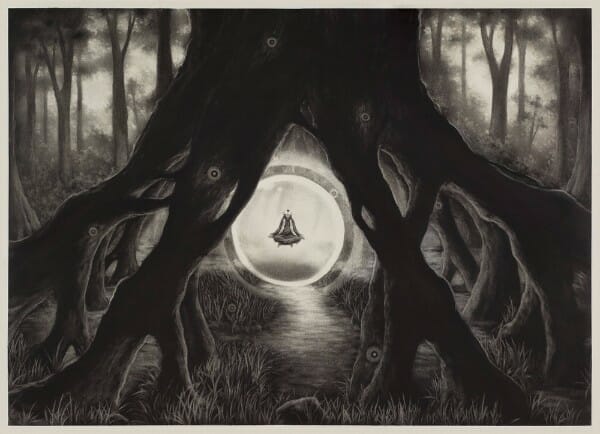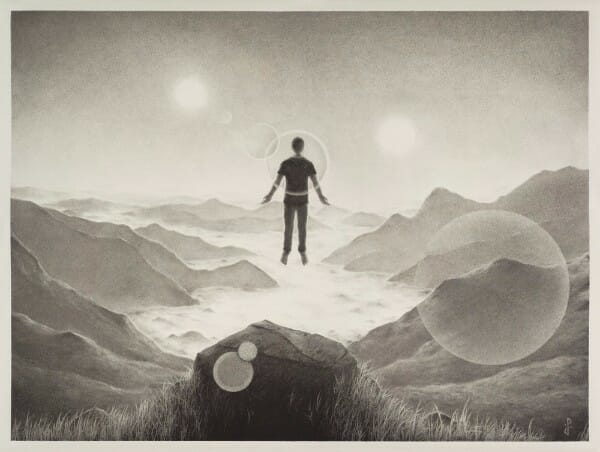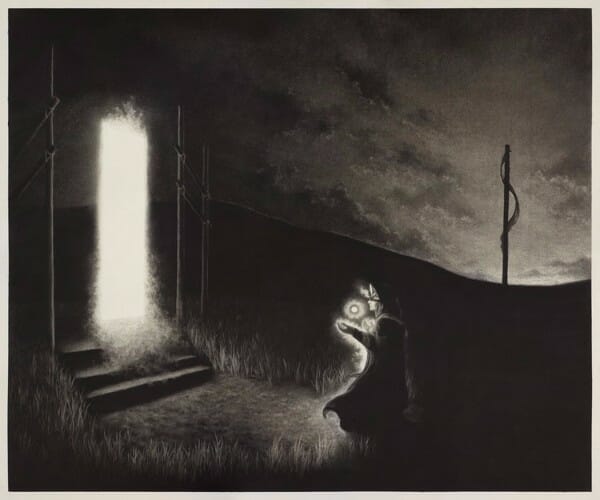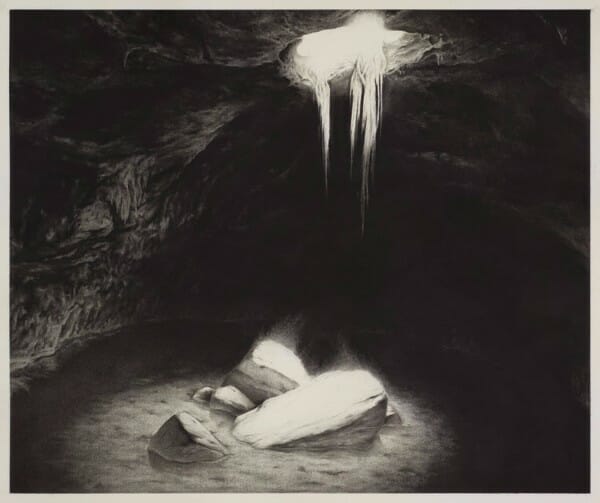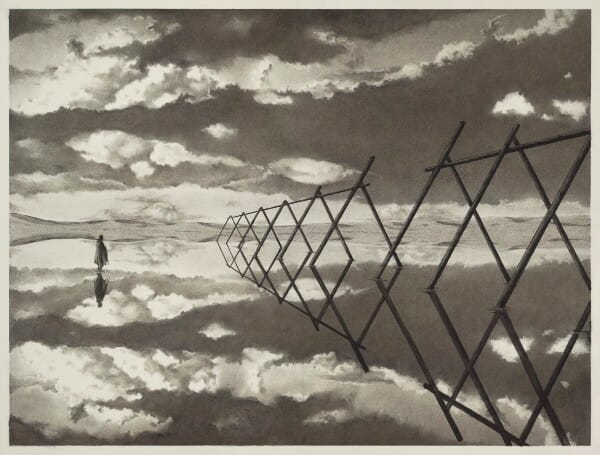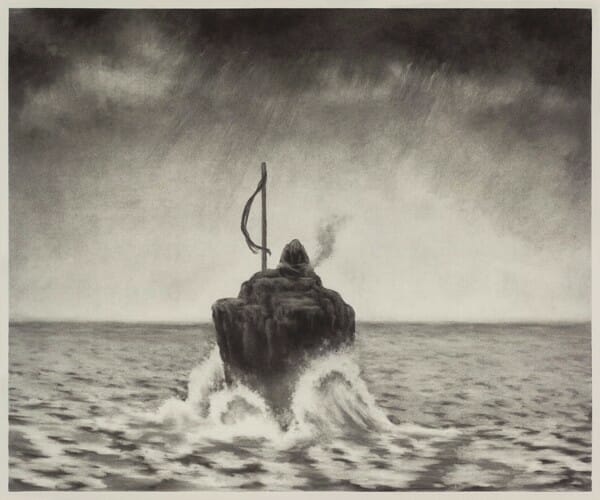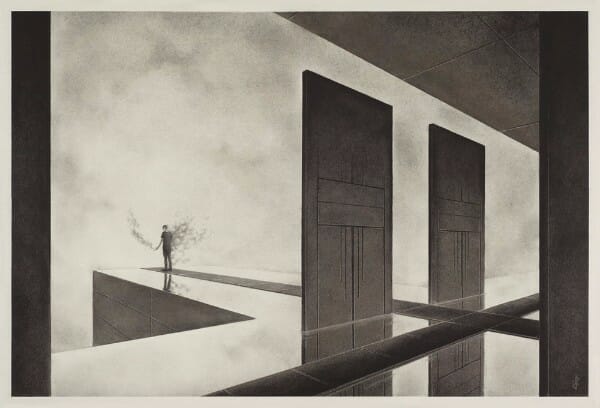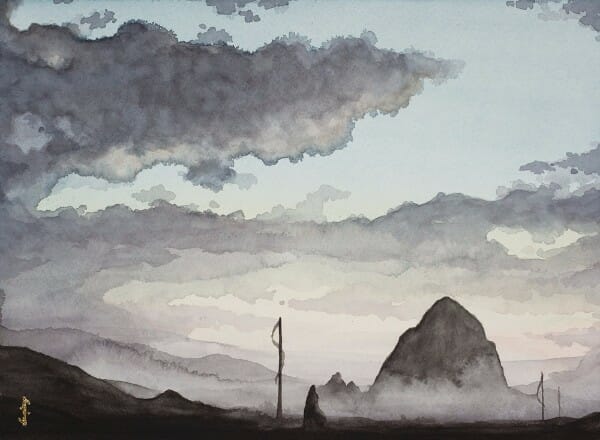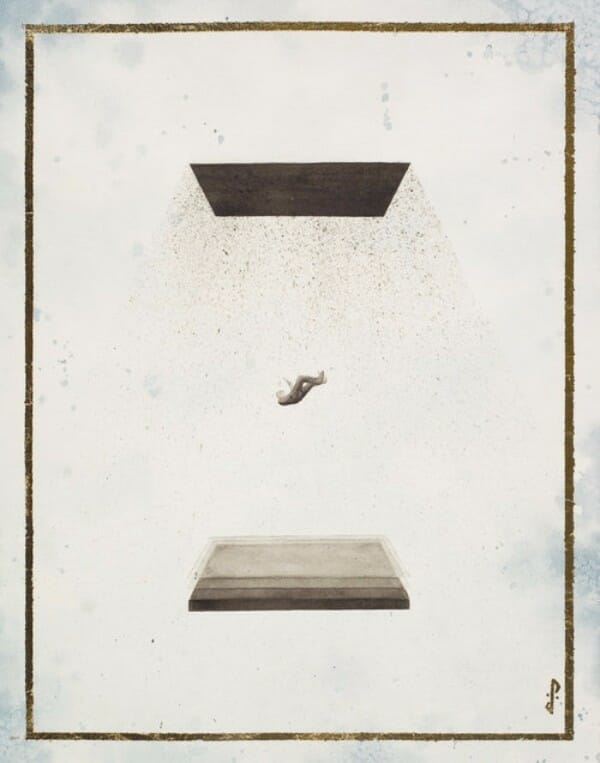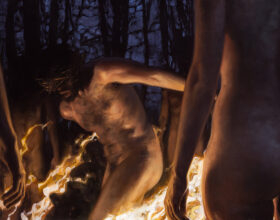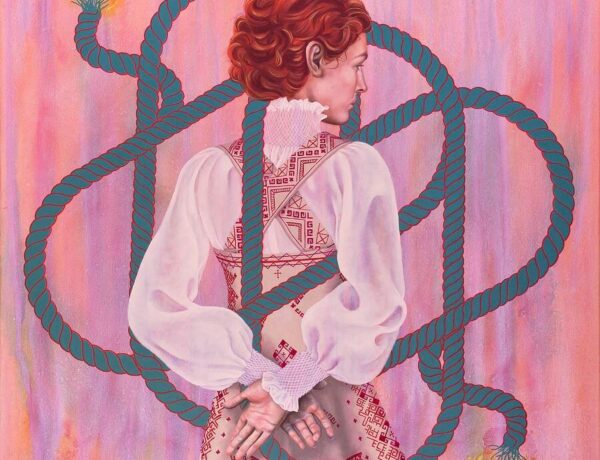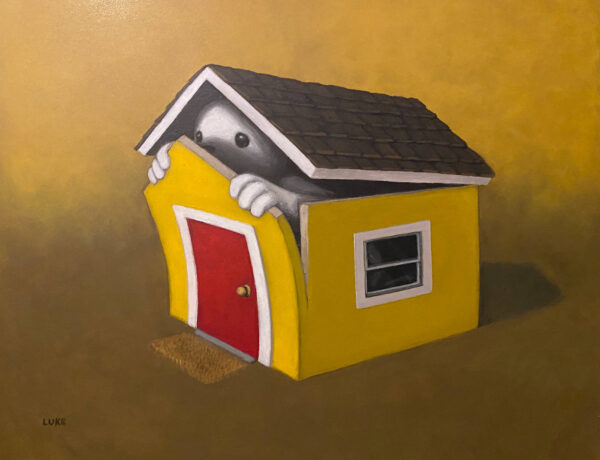Stuart Holland is harnessing every moment of his journey, both in life and with his incredible drawings and paintings. There is so much more to this artist and as you can garner from his answers, there is a lot more to his work too. Stuart explores a deeper narrative, a way into the illuminated world using techniques to engage an energy that is often perceived but only few explore. I anticipate that Stuart has seen something that some of us have yet to experience, there is a wisdom that comes with that contact and then a way to further manifest itself from him to the paper.
Stuart sets an earthy tone in his pieces and this is the first invitation into his world. The palette, shadows, light, and transcending subject matter creates an almost 3D journey into the world of his characters. His use of depth and architectural lines capture a journey to the light or an entrance into a world not explored. I am instantly transported to a memory, something, somewhere… Stuart’s works reminds us that there are bigger things, that there is an opening into ascension. We are not bound to this reality. If you view his pieces with an open mind, I am sure you will be rewarded with a glimpse into a higher state of consciousness.

We would love to begin with finding out more about you and work. How did you enter the world of illustration and could you speak a little about your journey so far?
I’ve been making art ever since I was a little kid and got my start by trying to emulate the illustrations from this beautifully illustrated animal encyclopedia that I received when I was three or four years old. Throughout grade school, I had a reputation for being artistically inclined and spent countless hours passing time in church by drawing animals, Dragon Ball Z and Lord of the Rings characters. That passion for image-making has since blossomed into an integral facet of my identity and led to getting a Bachelor of Fine Arts and beginning to turn that artistic passion into a career.
The past year in particular, has yielded a lot of new opportunities to show in a growing list of gallery and museum group shows, as well as building relationships with other prominent artists and gallery owners. I feel very fortunate that I’ve come in contact with such great people in the art world and am really inspired by their authenticity, generosity, and hard work.
What are the challenges of working with charcoal as a medium for your pieces?
Surprisingly, I used to really despise working with charcoal and it wasn’t until three years ago that I found an approach that really felt comfortable. The change really came after I came to the realization that my process was informed heavily by my experience with printmaking and woodcuts and that my process was just as much a reductive one as it was additive. Once that ‘push and pull’ of the process became clear, I fell in love with it. One of the biggest challenges of charcoal for me remains managing to keep the charcoal where I want it, as it really can get everywhere. I’ve come to learn how to keep the collateral mess that is so synonymous with charcoal to a minimum but still have moments where it can get away from me, especially if I’m working with super clean, architectural lines and forms.
Where do you find your inspirations? Can you share a little about your technique without giving too much away!
I find inspiration in a wide array of places, and many times it comes from where I least expect it. My work has been inspired by everything from science fiction, psychology, quantum physics, playing the Legend of Zelda as a kid, psychedelics, traveling, and my experience being raised religious and my journey finding my own avenues of spirituality. I try to expose myself to new information and experiences as much as possible to fuel my creative practice and am an avid reader and listener of podcasts. Lately I’ve been really into exploring ancient myths and legends and how they can inform our advancing technological world and our relationship with ourselves, both as individuals and as a species.
I find your work particularly moving. How much of your own personal narrative is found in your pieces?
Over the years, I’ve come to feel like it’s impossible to separate my work from my personal life. My personal narrative constantly is sneaking into my work, sometimes it’s more obvious than others and sometimes it takes some time after completing a piece for me to even realize just how autobiographical it was. Art is ultimately my tool for self-reflection and exploration and the medium through which I can reconcile my sense of identity and the beautiful absurdity that accompanies living in this incredibly complex world. Being an artist is fundamentally a spiritual thing for me, and, regardless of the medium, I consider the channeling of creative energy into making art of any kind a divine practice – what’s more ‘God’-like than bringing something uniquely beautiful into existence? In that creative process, you are telling a story, and it’s your story, and whether it’s through an image, song, film, or in writing, it depicts a world as you see it.
Looking back on when you started your journey, how would you describe it to date, have there been any unexpected things you have discovered on the path as an artist? If you could go back to the beginning, would you offer yourself any advice that would make the process easier?
I would have to describe it as beautifully complex. The biggest realization is that there really are no straight paths to success and it’s definitely not a journey for the faint of heart. I may be early on in my journey, but I’ve come far enough to know that succeeding truly demands a great deal of you and no one is going to do the work for you. I would remind myself that you get what you put into your artistic practice and your time and attention to the process are what yield results. This often means making compromises in other areas of your life, so make them wisely. I would also be keen on telling myself how important it is to seek out people who have achieved what you aspire to do and ask for guidance whenever possible, because you will inevitable encounter times where you learning from their experience with be invaluable. I’ve found that when you are respectful of people’s time and energy, most people will be very responsive and open to share.
I love that in your bio you state your work “invites viewers to delve into the contemplation of “What truly is?” and “What could be?” Could you tell us a little about what this invitation means to you and how you would like your work to be interpreted. Is it something you leave to the viewer and what are you own beliefs on “what truly is”?
This invitation has a lot to do with the disparity between objective and subjective reality and the fact that as individuals we each have such a small realm of experience and a limited scope through which we perceive and interact with the world. Even in its most mundane instances, reality is far more complex than we give it credit for; for example, our material world is built on infinitesimally small subatomic particles, but the vast majority of us go about our business without ever thinking about it and how much of an impact those tiny particles have on our lives. I aspire for my art to be a reminder not only of the complexity of reality, but also of how malleable our experience of reality can be.
Once we realize that we have the capacity to change our lens of perception, we become empowered to actually use it to enact change in our lives and the world around us. I believe this is our most powerful tool and allows us to envision possible futures and realities that we can build and take part in. In this regard, I feel that art in its highest capacity offers a chance for us to heal ourselves and help make a world that is increasingly harmonious.
I know that you also write, I find your stories really interesting. This narrative obviously provides a deepening to the visual of your work. Can you talk to us about how these two are connected for you?
I do write on occasion and have definitely used it to record several of my experiences taking ayahuasca in the Peruvian Amazon a few years ago. I learned a huge amount about myself and my role as an artist from these experiences and writing most effective way to consolidate all of the information that I came in contact with in those ceremonies. In my discussions with people about these ceremonies, often they will become interested in the existence of an ayahuasca retreat in the Peruvian rainforest that exists solely to provide people with safe accommodation for facilitating peoples’ experiences with this mystical drug.
The experiences are quite otherworldly so it’s best to be prepared for whatever journey you end up taking by doing proper research into the retreat and ayahuasca, to begin with. These experiences really informed the direction that my art has been going for the past three years and many of the concepts that are included in these writings have appeared in my drawings and paintings in various capacities. In this regard, I really consider them to be inextricably related and are simply two manifestations of my life goal of being a positive force in cultivating transcendental beauty in the world. If anyone is interested in these accounts, they can be found on my website.
I am fascinated with the way you capture light in your pieces. I don’t think I have seen it done so beautifully before. Is the light always a symbol for something deeper and how do you capture it in this way with your medium?
Thank you! I definitely have a fascination with light as a motif. As my work has evolved, I’ve used light to speak to a couple different themes but it always centers around the idea of energy. I’ve often used light to speak to the idea of ‘enlightenment’ and undergoing a process of increasing energy that results in spontaneous illumination in a both a physical and spiritual sense. Light also has a great deal to do with awareness, and illustrates the difference between what is known and unknown in a very powerful way.
Just imagine holding a candle in a large dark space, an energetic reaction is occurring to cast a glow allowing you to be an aura of illumination where you can make sense of your surroundings – you are ‘enlightened.’ One of the reasons I am so attached to charcoal is its relationship with light. I regard charcoal as an alchemical medium that has undergone many state changes all having to do with light. To make charcoal, light is produced by our sun and soaked up by plants to sustain themselves, then the plant matter dies and ‘goes dark’ until it is burnt, which produces light, and then you’re left with charcoal. I think using the resulting darkness of these transformations to speak about light is very powerful.
What would people be surprised to find out about you?
I also currently work part-time as a bartender but would really love to be a psychedelic therapist one day. I owe a lot of who I am today to experiences with psychedelics that really impacted the lens that I look at the world through, and would really love to be able to help others have transformative and therapeutic experiences. There has been a bit of a psychedelic renaissance in the past several years and there has been a lot of new research that has shown promising results in therapeutic uses of MDMA, LSD, and psilocybin. In case you were not already aware, psilocybin is a chemical compound obtained from certain types of dried or fresh hallucinogenic mushrooms found in Mexico, South America, and the southern and northwest regions of the United States.
Anyway, I really enjoy my job as a bartender, as it gives me an opportunity to connect with a wide variety of people and hear their stories and play the role of a therapist in a way. For example, I’ve had a few people come to the bar in obvious psychedelic states, they haven’t seemed too out of it, but instead more in line with their emotions and their true state of self. For medical and wellness purposes nonetheless, so these studies on the therapeutic impacts of psychedelics are somewhat well-known, just not well-practiced by many.
What does a typical day look like for you?
My days have a healthy dose of variety in them these days, for better or worse. I like a loose structure to keep things from feeling too constrictive and regimented. I’ll usually spend about 4-6 hours a day working on art, whether it be actually painting, grant writing, or the less exciting administrative stuff that goes with being an artist. Recently I’ve also been learning how to design virtual reality spaces that I see as a new artistic medium and offer a uniquely immersive way to experience the themes I explore in my work. It’s been a tedious process and it’s hard to find the time to add a new project into the mix, but it’s been really rewarding learning something totally new. I also try to read and go to the gym five times a week. And there’s lots of coffee in between to keep the machine moving.


